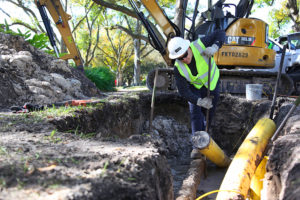Reducing Emissions
For over a decade, our strategy has been the driving force in reducing greenhouse gas (GHG) emissions from our fossil-fuel generation. Between 2005 and 2016, our GHG emissions fell by 14 per cent – from 27.3 megatonnes CO2e to 23.5 megatonnes CO2e (adjusted to account for our merger with TECO Energy in 2016). This is due in large part to our changing energy generation mix. Over the same period, the percentage of coal used as a fuel source for generation at Emera decreased by 55 per cent, and was replaced by our investments in wind, solar, hydro and lower-carbon natural gas.
Reporting Our Progress
In 2016, Emera received a CDP score of B (Management). This means Emera was recognized by CDP for taking coordinated action on climate change issues. Our score of B was higher than the average scores for other companies in our industry, our region and the CDP program as a whole. TECO Energy has been incorporated in our 2017 submission to CDP with scoring on our submission expected in late fall.
Nova Scotia
In Nova Scotia, we’ve reduced our greenhouse gas emissions by more than 30 per cent since 2005 and have helped contribute to Canada’s emissions reduction commitment under the Paris Climate Accord. We tripled renewable energy production in Nova Scotia over the past decade. As a result, in 2016 we reached 28 per cent renewable energy with the highest amount of wind as a percentage of generation in Canada. We’ve achieved the most rapid transition to renewable energy of any utility in Canada and we’re on track to meet our 40 per cent renewable energy target by 2020.
Nova Scotia Power’s website, Today’s Power, makes renewable energy use visible and relevant to our customers. The online tool shows real-time information about our generation mix and forecasts how our energy mix will look in 2020.
Barbados
We believe that by 2045 we can power Barbados from 100 per cent renewable energy, and that 100 per cent of energy used on the island will be from electricity. This will be a remarkable transformation, considering the island was completely reliant on fossil fuels just a few years ago. Solar is already a big part of our generation plans. Our new 10- MW St. Lucy solar installation in Barbados means 70,000 barrels of oil are no longer imported and burned, cutting carbon emissions by 21,000 tonnes a year. As we develop a smarter grid, we will be able to retire legacy fossil-fueled plants, slashing GHG emissions from our generation in Barbados.

Since 2011, more than 7,800 kilometres of cast-iron and bare steel pipe in Peoples Gas' distribution system have been replaced, which has reduced fugitive methane emissions, a greenhouse gas, by 16,455 tCO2e.
Florida & New Mexico
Tampa Electric is one of the lowest- emitting utilities with coal-fired generation, and we continue to outperform the U.S. electric sector in GHG emissions reductions. We made a further significant investment in solar generation in 2016 by building the 23-MW solar array near Tampa Electric’s Big Bend Power Station. It began operations in 2017 and is the largest solar array in the Tampa Bay area with the capacity to power more than 3,300 homes, cutting CO2 emissions by 27,000 tonnes per year.
In early 2017, Tampa Electric completed an upgrade to four existing simple-cycle, natural-gas fired units at Polk Power Station to a more efficient combined-cycle unit. The unit captures the waste heat from the existing combustion turbines and increases the output of the gas-fired units by 70 per cent. This expands the generating capacity at the site by 460 MW, or enough electricity to power more than 100,000 homes. The project will reduce emissions of carbon dioxide by 37 per cent per MWh. It will also reduce nitrogen oxide by 86 per cent per MWh.
The teams at Peoples Gas and New Mexico Gas are also doing more to reduce methane emissions. Both have joined the U.S. Environmental Protection Agency’s (EPA) voluntary Natural Gas STAR Methane Challenge Program, which targets reducing methane emissions by 40 to 45 per cent below 2012 levels by 2025. Launched in 2016, the challenge allows us to make and track commitments in collaboration with the EPA to reduce methane emissions and demonstrate their efforts to improve air quality.
The US Regional Greenhouse Gas Initiative
Emera Energy was our only affiliate required to participate in an emissions trading framework in 2016. Under the legislated Regional Greenhouse Gas Initiative (RGGI), Emera Energy acquired offsets for emissions from their natural gas generating facilities located in the United States.
Direct (Scope 1) GHG emissions from Emera's generating capacity in 2016
23,424,741
(tCO2e)
Indirect (Scope 2) GHG emissions from electricity purchased by Emera in 2016
5,582
(tCO2e)
GHG emissions intensity ratio from Emera's Scope 1 and Scope 2 emissions in 2016
0.58
(tCO2e per MWh of total sales)Note: as reported in Emera's 2017 CDP submission.
Note: Scope 1 and Scope 2 GHG emissions are adjusted to include 12 months of TECO data, as well as Emera's historical emissions, to align with CDP reporting.
Emera’s Evolving Fuel Mix 2005–2016
Notes: based on sources of energy as a percentage of total GWh generated by Emera in 2005 and 2016 respectively, including purchases. 2005 figures are based on Emera’s company structure and assets at that time.
Emera Annual Scope 1 GHG Emissions from Thermal Generation (MtCO2e)
Emera’s 2016 CDP score (B) compared to industry benchmarks
Source: 2016 Climate Change Basic Performance Review Report for Emera, Inc., ADECO Innovations.



